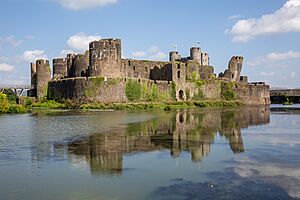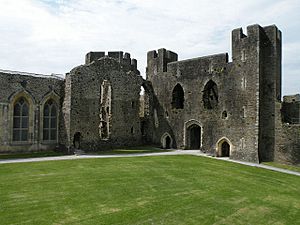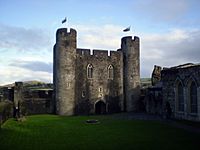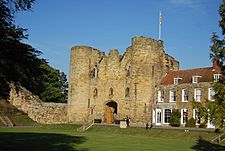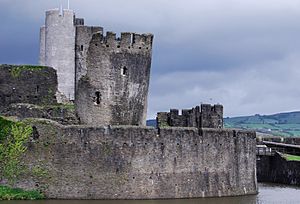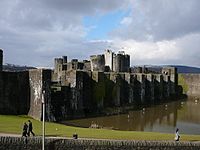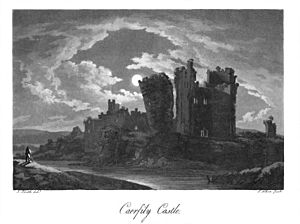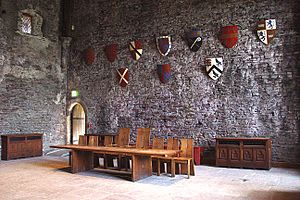Caerphilly Castle facts for kids
Quick facts for kids Caerphilly Castle |
|
|---|---|
| Part of the Caerphilly County Borough | |
| Caerphilly, Wales, United Kingdom | |
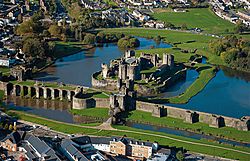
Caerphilly Castle and moat
|
|
| Type | Medieval concentric castle |
| Area | Around 30 acres (12 ha) |
| Site information | |
| Owner | Cadw |
| Condition | Ruined, with partial restoration |
| Site history | |
| Built |
|
| Built by |
|
| In use | Open to public |
| Materials | Pennant Sandstone |
| Events | Welsh Wars Invasion of England English Civil War |
|
Listed Building – Grade I
|
|
| Official name | Caerphilly Castle |
| Designated | 28/01/1963 |
| Reference no. | 13539 |
| Official name | Caerphilly Castle |
| Reference no. | GM002 |
Caerphilly Castle (Welsh: Castell Caerffili) is a huge medieval castle in Caerphilly, South Wales. It was built by Gilbert de Clare in the 1200s. He wanted to control the area called Glamorgan. The castle saw many fights between Gilbert's family and the Welsh rulers.
This castle is famous for its amazing water defenses. Historian Allen Brown called them "the most elaborate water defences in all Britain." The castle is surrounded by large artificial lakes. It covers about 30 acres, making it the biggest castle in Wales. It is also the third-largest in the United Kingdom, after Dover Castle and Windsor Castle.
Caerphilly Castle was one of the first castles in Britain to use "concentric" defenses. This means it had rings of walls, one inside the other, making it very strong. It also has very large gatehouses. Gilbert started building in 1268. Most of the work was done in the next three years, costing a lot of money.
The Welsh prince Llywelyn ap Gruffudd did not like the castle being built. He attacked and burned the site in 1270. Royal officials even took over the castle for a short time in 1271. But Gilbert finished the castle and took control of the region. The castle's main part, including fancy living areas, was on a central island. This island was surrounded by the artificial lakes. The design was probably inspired by Kenilworth Castle. The dams that held back the lakes were also fortified. An island to the west added more protection.
The castle was attacked several times. This included during the Madog ap Llywelyn revolt in 1294, the Llywelyn Bren uprising in 1316, and when King Edward II was overthrown in 1326–27. By the late 1400s, the castle started to fall apart. By the 1500s, the lakes had drained, and people took stones from the walls.
The Marquesses of Bute bought the castle in 1776. The third and fourth Marquesses did a lot of work to restore it. In 1950, the castle was given to the Welsh government. The water defenses were filled again. Today, the Welsh heritage agency Cadw looks after the castle. It is a popular place for tourists to visit.
Contents
History of Caerphilly Castle
Building the Castle in the 1200s
Caerphilly Castle was built in the second half of the 1200s. This was part of the Norman expansion into South Wales. The Normans started moving into Wales from England in the late 1060s. They built castles and created new lordships as they went. The earls of Gloucester were given the job of taking over Glamorgan in 1093. They kept trying throughout the 1100s and early 1200s. There was a lot of fighting between the Norman lords and the Welsh rulers.
In 1263, Gilbert de Clare inherited the family lands. People called him "Red Gilbert" because of his hair. His main rival in Glamorgan was the Welsh prince Llywelyn ap Gruffudd. Llywelyn had become very powerful during a civil war in England in the 1260s. In 1265, Llywelyn made a deal with the rebel lords in England. He was given control over all Welsh leaders in the region, including Glamorgan. Gilbert de Clare felt his lands were in danger. So, he joined forces with King Henry III against the rebels and Llywelyn.
The rebel uprising ended between 1266 and 1267. This left Gilbert free to move north into Glamorgan from his base in Cardiff. Gilbert started building a castle at Caerphilly in 1268 to control his new lands. The castle was in a valley near the Rhymney River. It was also close to an old Roman fort and a network of roads.
Work on the castle began very quickly. Ditches were dug to shape the castle. Temporary wooden fences were put up. Large water defenses were made by damming a local stream. The walls and buildings were built fast, forming the main part of the castle. We do not know who designed the castle or its exact cost. But experts think it might have cost as much as £19,000. This was a huge amount of money back then.
Llywelyn sent his own forces to stop the building. But King Henry III stepped in to prevent a full war. Gilbert kept building. In 1270, Llywelyn attacked and burned the site. He probably destroyed the temporary defenses and supplies. Gilbert started building again the next year. This made tensions rise. So, King Henry sent two bishops to take control of the site. They were supposed to find a solution to the problem.
The bishops took over the castle in late 1271. They promised Llywelyn that building would stop for a while. They also said talks would start the next summer. But in February of the next year, Gilbert's men took the castle back. They kicked out the bishops' soldiers. Gilbert claimed he was innocent of these events. He started building again. Neither Henry nor Llywelyn could easily stop him. So, Gilbert was able to claim all of Glamorgan. Work on the castle continued. More water defenses, towers, and gatehouses were added.
Llywelyn's power weakened over the next 20 years. In 1277, King Henry's son, Edward I, invaded Wales. This broke Llywelyn's power in South Wales. In 1282, Edward's second campaign led to Llywelyn's death. This ended independent Welsh rule. More defenses were added to the castle walls until about 1290.
Local problems still happened. Gilbert de Clare argued with Humphrey de Bohun in 1290. The next year, the king heard the case. This led to Caerphilly being temporarily taken over by the king.
In 1294, Madog ap Llywelyn led a rebellion against English rule. This was the first big uprising since 1282. The Welsh were angry about new taxes. Madog had a lot of support. In Glamorgan, Morgan ap Maredudd led the local uprising. Morgan had lost his lands to Gilbert de Clare in 1270. He saw this as a chance to get them back. Morgan attacked Caerphilly. He burned half the town but could not take the castle. In spring 1295, Edward fought back in North Wales. He stopped the uprising and arrested Madog. Gilbert de Clare attacked Morgan's forces. He took back the region between April and May. Morgan then surrendered. Gilbert de Clare died at the end of 1295. Caerphilly Castle was in good shape. It was connected to the small town of Caerphilly and had a large deer park nearby.
From the 1300s to the 1600s
Gilbert's son, also named Gilbert de Clare, inherited the castle. But he died young in 1314, fighting at the battle of Bannockburn. The family's lands were first put under the king's control. But before any decisions were made, a revolt started in Glamorgan. People were angry about the royal administrators. Llywelyn Bren led an uprising in January 1316. He attacked Caerphilly Castle with many men. The castle held out, but the town was destroyed. The rebellion spread. A royal army was sent to deal with it. They defeated Bren in a battle at Caerphilly Mountain. This broke the Welsh siege of the castle.
In 1317, King Edward II gave Glamorgan and Caerphilly Castle to Eleanor de Clare. She had married the king's favorite, Hugh le Despenser. Hugh used his connection to the king to gain more power. He took over lands across South Wales. Hugh hired Master Thomas de la Bataile and William Hurley to make the Great Hall at the castle bigger in 1325–1326. They added beautifully carved windows and doors.
In 1326, King Edward's wife, Isabella of France, overthrew his government. This forced the king and Hugh to run away. They stayed in Caerphilly Castle in late October and early November. Then they left to escape Isabella's army. They left behind many supplies and £14,000 at the castle. William la Zouche surrounded the castle with 425 soldiers. He trapped the castle's commander, Sir John de Felton, Hugh's son (also named Hugh), and 130 soldiers inside. Caerphilly held out until March 1327. The soldiers surrendered on the condition that the younger Hugh would be forgiven. His father had already been executed.
Tensions between the Welsh and English continued. They led to the Glyndŵr Rising in 1400. We are not sure what part the castle played in this conflict. But it seems to have survived without much damage. It was captured by Glyndwr's forces during the rebellions. In 1416, the castle passed to Isabel le Despenser through marriage. She and her second husband, Richard Beauchamp, spent a lot of money on the castle. They repaired it and made it a good home for themselves. The castle then passed to Richard Neville in 1449 and to Jasper Tudor in 1486.
After 1486, the castle started to decline. It was less popular than Cardiff Castle. Once the sluice-gates broke, the water defenses probably drained away. The historian John Leland visited Caerphilly Castle around 1539. He said it had "walls of a wonderful thickness." But other than a tower used for prisoners, it was in ruins. It was surrounded by marshland. Henry Herbert used the castle for his court. In 1583, the castle was rented to Thomas Lewis. He took many stones from it to make his house bigger. This caused a lot of damage.
In 1642, the English Civil War began. This was a fight between the Royalist supporters of King Charles I and those of Parliament. South Wales mostly supported the Royalists. During the war, a small fort was built overlooking Caerphilly Castle. It was on the site of the old Roman fort. We are not sure if Royalist or Parliamentary forces built it. But its guns would have controlled the inside of the castle. We also do not know if Parliament purposely damaged Caerphilly Castle. This would have stopped it from being used as a fort again. Some towers had fallen by the 1700s. This might have been from such an action. But it was probably because the ground sank when the water defenses dried up. There is no clear proof that it was purposely destroyed.
From the 1700s to Today
The Marquesses of Bute bought the castle in 1776. John Stuart, the first marquess, worked to protect the ruins. His great-grandson, John Crichton-Stuart, was very rich. This was because his family owned coal mines in South Wales. He was also very interested in medieval history. He had the castle surveyed by an architect named William Frame. He also put a new roof on the great hall in the 1870s. The marquess started buying back properties around the castle. He wanted to clear away the houses that had been built close to the site.
The fourth marquess, John Crichton-Stuart, loved restoring old buildings. He started a big restoration project between 1928 and 1939. The stonework was carefully fixed. Molds were made to recreate missing parts. The Inner East Gatehouse was rebuilt, along with several other towers. The marquess also worked on the landscape. He planned to eventually refill the lakes. Thanks to buying land for many years, he was finally able to tear down the local houses that blocked the view of the castle.
By 1947, when John Crichton-Stuart, the fifth marquess, inherited the castle, the Bute family had sold most of their land in South Wales. John sold the rest of the family's property. In 1950, he gave Caerphilly Castle to the Welsh government. The lakes were refilled. The last parts of the restoration were finished in the 1950s and 1960s. The South Lake was meant to be refilled for the 1958 Empire Games. The East Moat was refilled with water in 1962.
Today, the Welsh heritage agency Cadw manages the castle. It is a popular tourist attraction. In 2006, over 90,000 people visited the castle. It is protected as a scheduled monument and a grade I listed building. The Great Hall can even be used for wedding ceremonies.
Castle Design and Features
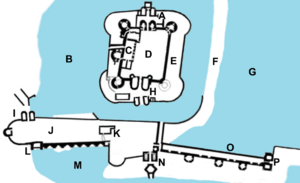
Caerphilly Castle has eastern defenses, protected by the Outer East Moat and the North Lake. It also has strong areas on the Central Island and the Western Island. Both are protected by the South Lake. The whole site is about 30 acres. This makes it the second largest castle in Britain. It is built on a natural gravel bank in the local river valley. The castle walls are made from Pennant sandstone.
The castle's design is very famous and important. It was the first castle in Britain to use "concentric" defenses. This changed how military buildings were designed in the country. It also had huge gatehouses. The castle also had a clever system of moats and dams. Historian Allen Brown called them "the most elaborate water defences in all Britain."
You would reach the eastern defenses through the Outer Main Gatehouse. This gatehouse had round towers with pyramid-shaped bases. This design was special to castles in South Wales. Originally, you would cross two drawbridges to reach the gatehouse. There was a tower between them, but it is now gone. To the north of the gatehouse was the North Dam. It was protected by three large towers. It might have held the castle's stables. Even with some damage, the dam still holds back the North Lake.
The South Dam was a massive structure, 152 meters long. It ended in a huge wall with supports. The remains of the castle mill are still there. It was powered by water from the dam. Four fake siege engines are on display. The dam ended at Felton's Tower. This was a square fort that protected the sluice gates. These gates controlled the water levels of the dam. The South Gatehouse, also called Giffard's Tower, was originally reached by a drawbridge. It led into the town.
Caerphilly's water defenses were almost certainly inspired by those at Kenilworth Castle. Kenilworth had similar artificial lakes and dams. Gilbert de Clare had fought at the siege of Kenilworth in 1266. So, he would have seen them firsthand. Caerphilly's water defenses were especially good at protecting against mining. This was a way enemies could dig under castle walls. These defenses are considered the most advanced of their kind in Britain.
The central island held Caerphilly's inner defenses. It was roughly square with an inner and middle wall. The inner wall was protected by four towers at each corner. The walls of the inner area were higher than those of the middle area. This created a concentric defense of two enclosed rings of walls. In medieval times, the middle wall would have been much taller than it is today. This would have made it a stronger defense. Caerphilly was the first concentric castle in Britain. It was built a few years before King Edward I's famous concentric castles. Its design influenced Edward's later castles in North Wales. Historian Norman Pounds calls it "a turning point in the history of the castle in Britain." The south-east tower in the Inner Ward leans outwards by 10 degrees. This is probably because the ground has sunk.
You would get to the central island by a drawbridge. This led through two gatehouses on the eastern side. Caerphilly Castle's Inner East Gatehouse was based on the gatehouse at Tonbridge Castle from the 1250s. It helped start a trend in gatehouse design across England and Wales. This type of gatehouse is sometimes called a "keep-gatehouse." It had defenses both outside and inside. This meant it could still be defended even if the castle's outer walls were broken. Two huge towers stood on either side of the entrance. The entrance was protected by portcullises (heavy grates) and murder-holes (holes for dropping things on attackers). The gatehouse was very large. It was used for living as well as defense. It was very comfortable and grand. It was probably used by the castle's commander and his family. Another pair of gatehouses protected the west side.
Inside the inner area was the castle's Great Hall and living spaces. Caerphilly was built with stylish, high-status rooms. These were similar to those built around the same time at Chepstow Castle. In medieval times, the Great Hall would have been divided by wooden screens. It would have had colorful decorations and detailed carvings. A large central fireplace would have kept it warm. Some carved medieval corbels (stone supports) shaped like heads still exist in the hall today. They might show the royal court in the 1320s. This could include Edward II, Isabella of France, Hugh Despenser, and Eleanor de Clare. To the east of the Great Hall was the castle chapel. It was above the buttery and pantry. On the west side of the hall were the castle's private apartments. These were two luxurious living areas.
Beyond the central island was the Western Island. You probably reached it by drawbridges. The island is called Y Weringaer or Caer y Werin in Welsh. This means "the people's fort." It might have been used by the town of Caerphilly for protection during conflicts. On the north-west side of the Western Island was the site of the old Roman fort. It covered about 3 acres. The remains of the 17th-century civil-war fort are also in the same spot.
See also
 In Spanish: Castillo de Caerphilly para niños
In Spanish: Castillo de Caerphilly para niños
- Castles in Great Britain and Ireland
- List of castles in Wales
- Castell Coch, also restored by the Marquesses of Bute


